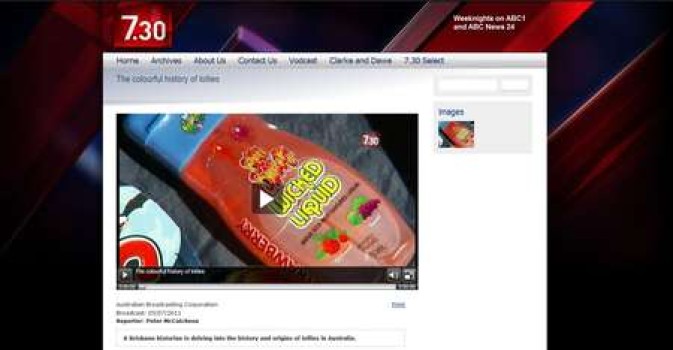Delving into the history and origins of lollies in Australia.
Australian Broadcasting Corporation
Broadcast: 05/07/2011
Reporter: Peter McCutcheon
A Brisbane historian is delving into the history and origins of lollies in Australia.
Transcript
LEIGH SALES, PRESENTER: Australians sometimes feel anger and loss when iconic Aussie companies are sold to overseas interests, like for example when America's Campbell Soup Company took over the much loved Arnott's Biscuits in the 90s. It's something that's also happened to confectionary. Lollies like Minties, Fantales, Freddo Frogs and Bertie Beetles were all developed locally, but bought out by international conglomerates. The Australian heritage of those products isn't always easy to track as the years pass. But one Brisbane social historian is giving it a go. Peter McCutcheon reports.
PETER MCCUTCHEON, REPORTER: It's just sugar, gelatin, a bit of starch and food colouring, so why are they so fascinating?
TONI RISSON, UNIVERSITY OF QUEENSLAND: Well they taste fantastic for a start. They're also a bit of a gustatory adventure, because you don't really know what you're going to get when you put it in your mouth. But I'm really interested too in those other aspects of lollies apart from just what they taste like. So, kids play games with them. Rolling Jaffas down the aisle in a picture theatre was a big part of our lolly history. The fact they look so beautiful, they look like jewellery. The fact that they give kids the power to enter into the world of the consumer: they're all aspects of our lolly history that we don't think about.
PETER MCCUTCHEON: It's more than just a sugar hit?
TONI RISSON: Oh yeah, much more than just a sugar hit!
PETER MCCUTCHEON: Social history researcher Toni Risson is looking into a popular but seldom-documented part of Australia's past. For the British they're sweets. For Americans, candy. But in the Australian vernacular, it's that delicious mouthful: lollies.
TONI RISSON: Well, I think lollies are magic. I don't think of them as food at all. I think, for kids they're part of the magic of childhood.
PETER MCCUTCHEON: At the turn of last century, Australia had hundreds of local lolly-makers. Many developed their own products.
TONI RISSON: I think there've probably been thousands and thousands of individual lolly types that have passed across the counter. Some were only designed to be just one batch. So a week and they're gone, they never come back again. So I'm also interested in which ones, what is it about those ones that become Australian icons like Minties, Fantales, Jaffas and the ones that you never hear from again, things like Monster Braid and Moonshine Biffs, what were they?
PETER MCCUTCHEON: One of those iconic lollies was developed by a small Australian family company that's still around today. The machinery is new, but the psychedelic-looking substance is based on a recipe developed over 80 years ago. This is the home of what's claimed to be the original sherbet bomb.
BOB MCQUADE, LAGOON CONFECTIONERS: Dad invented the sherbet bomb. And then when Dean came into the business, my son, he invented the fruity sherbet bombs.
PETER MCCUTCHEON: Bob McQuade is the second of three generations to have owned and operated the Melbourne-based Lagoon Confectioners. His children have continued the sweet family tradition.
TINA FINLAYSON, LAGOON CONFECTIONERS: I thought, "Oh, I need a job, I thought I will just work at the factory for a few months and see if I can find another job", but 20 years later I'm still here! And I just couldn't leave the family. I just... it's such a good family business, and I thought I just can't leave 'em.
PETER MCCUTCHEON: Also lasting three generations is the Brisbane-based Lewin's Confectioners. But unfortunately, the company didn't quite make its hundredth anniversary and closed down its Woolloongabba factory two years ago.
So have we still got bits of your factory here?
ATHOL LEWIN, LEWIN'S CONFECTIONERS: Yes, a few little bits that we found.
PETER MCCUTCHEON: This is very Queensland!
ATHOL LEWIN: Couldn't throw them away: that's a pineapple.
Into the 90s and from then on, we found things getting harder economically.
PETER MCCUTCHEON: Athol Lewin is proud of his family history and recently discovered the 1904 apprenticeship papers of his grandfather.
"Apprentice in the art and mystery of manufacturing confectionery"?
ATHOL LEWIN: Amazing, isn't it?
PETER MCCUTCHEON: It's quite poetic.
ATHOL LEWIN: I think in those days it was a mystery to most people, I think, and it definitely was an art.
PETER MCCUTCHEON: And this brings us back to Toni Risson's thesis: that lollies, especially in the early to mid 20th century, were a type of magic.
TONI RISSON: They did find that the lolly counter - this enchanting sort of place - they were just dazzled by the amount of the colour and the sparkle.
PETER MCCUTCHEON: Lollies have evolved over the years. Some have disappeared and new ones are invented, reflecting the values and mores of the times. And the lollies kids are buying today tell an interesting tale.
TONI RISSON: These kids tend to go for the disgusting things, like the excess of their culture comes out in their love for really gross lollies, so they like things called Rip Snorter, Booger Balls and Brain Blasters.
PETER MCCUTCHEON: And for the more conservative, the sherbet bomb is still being produced by a third generation of lolly-makers.
TINA FINLAYSON: We all seem to be happy in there. We joke around. I think it's the sugar, makes us high or something! We always seem to be laughing and having fun. We're serious, but we get our work done. But we have fun, jokes, and have a laugh.
